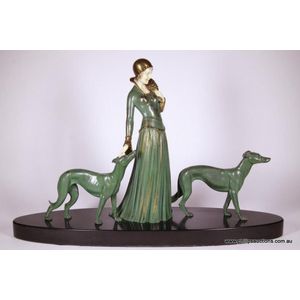Art Deco Figure with Greyhounds and Cloche Hat
You must be a subscriber, and be logged in to view price and dealer details.
Subscribe Now to view actual auction price for this item
When you subscribe, you have the option of setting the currency in which to display prices to $Au, $US, $NZ or Stg.
- Spelter - Spelter was the name given to an alloy of zinc and brass or copper used in the 19th century for statuary and lighting. It is a brittle bluish-white metal. It was used as a cheap replacement for bronze, but being brittle easily breaks and can't be repaired. When finished it can often be mistaken for bronze, but if discreet a scratch on the base displays shows a greyish colour, the metal is spelter, if a golden colour the metal is most likely bronze.
- Cold Painted - This is term applied to so-called "Vienna bronzes" manufactured in that city starting in late part of the 19th century, and it continued in the early 20th century, but was also used by sculptors working in other areas of Europe at the time..
Traditionally bronzes are finished by treating them with various acids and chemicals and heats, and the patina is incorporated into the surface of the piece.
A cold-painted bronze is decorated with oil paints. The color was not fired, hence the term "cold painted". Reputedly the painting was carried out mainly by women working at home, a typical cottage industry. - Art Deco Period - The Art Deco period was a cultural movement that emerged in the 1920s and 1930s, and was characterized by its emphasis on modernism, luxury, and elegance. The name "Art Deco" comes from the Exposition Internationale des Arts Décoratifs et Industriels Modernes, a large exhibition held in Paris in 1925 that showcased the latest trends in decorative arts.
Art Deco was a reaction against the ornate and elaborate styles of the previous era, and reflected a new modern sensibility. It was characterized by streamlined, geometric shapes, bright colours, and the use of new materials such as chrome, glass, and Bakelite. Art Deco designers sought to create a sense of luxury and sophistication, often incorporating expensive materials such as ivory, marble, and rare woods.
Art Deco had a significant impact on a wide range of artistic fields, including architecture, fashion, graphic design, and interior design. Some of the most iconic examples of Art Deco architecture include the Empire State Building in New York City, the Hoover Building in London, and the Palais de Chaillot in Paris.
The Art Deco period came to an end in the 1940s, as World War II and changing cultural trends led to a shift in artistic styles. However, Art Deco remains an important influence on design and art, and continues to be celebrated for its modernist sensibility and glamorous aesthetic.
This item has been included into following indexes:
Visually similar items


French bronzed spelter Art Deco figure of 'The Miner'. Signed to the back 'Rudens', crouching on a marble base. 36 cm high, 47 cm long

A French ormolu figure of a woman, Directoire circa 1795, the woman elegantly depicted standing with arm outstretched, in neoclassical dress, resting on a blue turquin marble socle, mounted with an acanthus ormolu collar, in turn resting on a square base,

Congo Colonial figure This figure has small, well-defined features to head and face, an elongated neck and body; the arms are carved free of the body and end in hands resting to the side; the legs have slightly bent knees; the chest has a hollow for fetish
